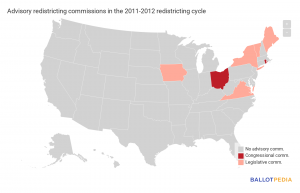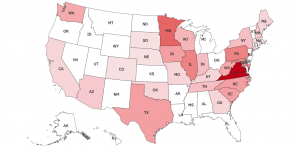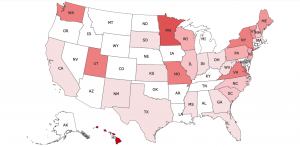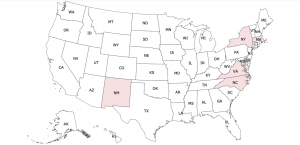Wisconsin governor establishes advisory redistricting commission
On Jan. 27, Wisconsin Gov. Tony Evers (D) signed an executive order creating an advisory redistricting commission. The commission will prepare congressional and state legislative district plans for Wisconsin lawmakers to consider. The plans are advisory, and the legislature will be under no obligation to accept the commission’s recommendations. The commission will be made up of members from each of the state’s congressional districts. Elected and political party officials, as well as lobbyists, will be barred from serving as commissioners. The order specified neither the number of commissioners nor the manner of appointment. It established the following criteria for the commission’s proposed maps:
- “Be free from partisan bias and partisan advantage”
- “Avoid diluting or diminishing minority votes, including through the practices of ‘packing’ or ‘cracking’”
- “Be compact and contiguous”
- “Avoid splitting wards and municipalities”
- “Retain the core population in each district”
- “Maintain traditional communities of interest”
- “Prevent voter disenfranchisement”
Evers said, “I believe, and Wisconsinites do, too, that people should get to choose their elected officials, not the other way around. So, when the People’s Maps are presented to the Legislature next year, I hope they will receive unanimous, bipartisan support.” Assembly Speaker Robin Vos (R) criticized the order, saying, “He can form whatever kind of fake, phony, partisan process he wants to create, but I have no doubt in the end we will do it the way we have always have, which is to follow the constitution.”
Upon completion of the census in 2020, congressional seats will be reapportioned to the states on the basis of population. Complete data sets will be delivered to the states in early 2021, at which time they will redraw their congressional and state legislative district maps. The Wisconsin congressional delegation is expected to remain unchanged at eight seats post-census. The legislature is responsible for drafting and adopting both congressional and state legislative district plans, both of which are subject to gubernatorial veto. Lawmakers are expected to take on redistricting as soon as census data is made available in early 2021.
What is an advisory redistricting commission, and how many states use them? An advisory redistricting commission advises state legislatures in drafting and implementing electoral district maps. These recommendations are not legally binding, though they can influence a legislature’s final decisions. An advisory commission is distinct from an independent commission, which can adopt maps without the involvement of the state legislature.
After the 2010 census, eight states used advisory commissions for some portion of the redistricting process. On the map below, states shaded in dark red used advisory commissions in congressional districting. States shaded in light red used advisory commissions in state legislative districting (note that Rhode Island used advisory commissions for both congressional and state legislative redistricting).

Missouri Supreme Court strikes down law requiring voters without photo ID to sign affidavits
On Jan. 14, the Missouri Supreme Court, in a 5-2 ruling, upheld a lower court’s decision striking down a state law requiring voters without photo identification to sign affidavits before voting. Missouri voters may now present either photo or non-photo identification at the polls and cast regular ballots without signing affidavits.
On Oct. 9, 2018, Richard Callahan, a state court judge, originally enjoined the affidavit provision. Callahan ruled that the affidavit’s language was “contradictory and misleading,” requiring signers to “swear that they do not possess a form of personal identification approved for voting while simultaneously presenting to the election authority a form of personal identification that is approved.” Callahan ordered officials to desist from executing the affidavit for voters presenting non-photo ID at the polls. Callahan also ordered officials not to distribute any materials indicating that a photo ID is required to vote. State officials appealed to the Missouri Supreme Court, asking it to stay Callahan’s order. On Oct. 19, 2018, the Court denied the request for a stay, but permitted the appeal to proceed. This allowed Callahan’s order to stand in advance of the Nov. 6, 2018, election.
The Court heard oral arguments in the appeal in Oct. 2019. Justice Mary Russell wrote the court’s opinion, which was joined by Chief Justice George Draper and Justices Paul Wilson, Patricia Breckenridge, and Laura Stith. Justices Wesley Powell and Zel Fischer dissented. Russell wrote, “Because the affidavit requirement of sections 115.427.2(1) and 115.427.3 is misleading and contradictory, the circuit court’s judgment declaring the affidavit requirement unconstitutional is affirmed. Further, the circuit court did not err in enjoining the State from requiring individuals who vote under the non-photo identification option provided in section 115.427.2(1) to execute the affidavit or in enjoining it from disseminating materials indicating photo identification is required to vote.”
Powell, joined by Fischer, wrote in his dissent: “If the affidavit requirement set forth in section 155.4271 is ambiguous, contradictory, and unconstitutional as the principal opinion proclaims, the opinion errs in severing the entire affidavit requirement without also severing the non-photo identification option set out in section 115.427.2 in its entirety. Because the legislature would not have enacted the non-photo identification option without an accompanying affidavit requirement, the principal opinion’s remedy is contrary to law.”
Ballot access requirements for U.S. House candidates in 2020
All seats in the U.S. House of Representatives are up for election in 2020. How do prospective candidates get on the ballot in their respective states?
Generally speaking, a candidate must pay a filing fee, submit petition signatures, or both in order to appear on the ballot. Filing requirements often vary from state to state and between districts within a state. Filing requirements also differ according to a candidate’s partisan affiliation. Candidates of the major political parties are sometimes subject to different requirements than unaffiliated candidates.
Petition signature requirements exist on a broad spectrum. For example, in Kentucky, a partisan candidate for the U.S. House must submit a petition containing two signatures in order to get on the ballot (the candidate must also pay a $500 filing fee). This petition requirement is the lowest in the country. By contrast, an unaffiliated candidate for Georgia’s 5th Congressional District must submit 26,538 petition signatures to get on the general election ballot, than in any other congressional district or state (the candidate must also pay a $5,220 filing fee).
- Note: Georgia’s filing requirements for independent and minor-party U.S. House candidates are currently the subject of ongoing litigation. Judge Leigh May, of the U.S. District Court for the Northern District of Georgia, upheld the requirements in 2019. The U.S. Court of Appeals for the Eleventh Circuit will hear oral argument in the case during the week of May 18-22. For more information, see Richard Winger’s coverage in Ballot Access News.
Filing fees are similarly variable. Of the states that require payment of filing fees, Kansas levies the lowest: $20 for unaffiliated candidates (the candidate must also submit 5,000 petition signatures). Meanwhile, in Arkansas, a Republican candidate must pay a filing fee of $15,000, a higher fee than in any other congressional district or state (the candidate does not need to submit petition signatures).
We have compiled complete filing requirements for major-party and unaffiliated candidates in all 435 U.S. House districts. To peruse the data, click here.
Legislation tracking
Redistricting legislation: The map below shows which states have taken up redistricting policy legislation this year. A darker shade of red indicates a greater number of relevant bills.
Redistricting legislation in the United States, 2020
Current as of Feb. 10, 2020

Electoral systems legislation: The map below shows which states have taken up electoral systems legislation this year. A darker shade of red indicates a greater number of relevant bills.
Electoral systems legislation in the United States, 2020
Current as of Feb. 10, 2020

Primary systems legislation: The map below shows which states have taken up electoral systems legislation this year. A darker shade of red indicates a greater number of relevant bills.
Primary systems legislation in the United States, 2020
Current as of Feb. 10, 2020


